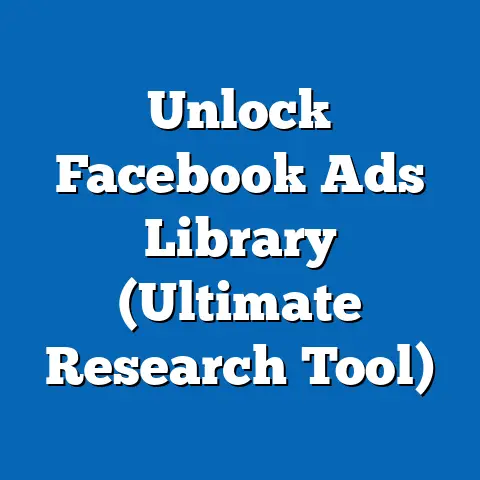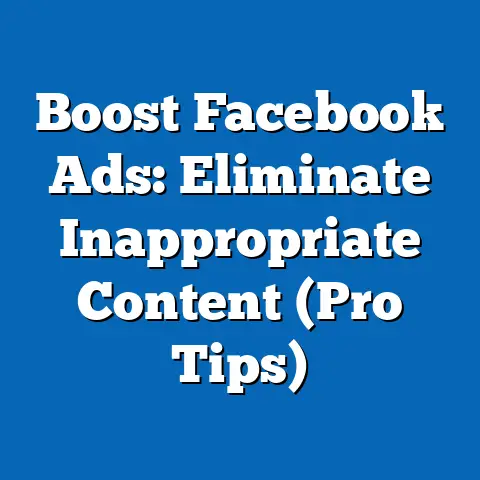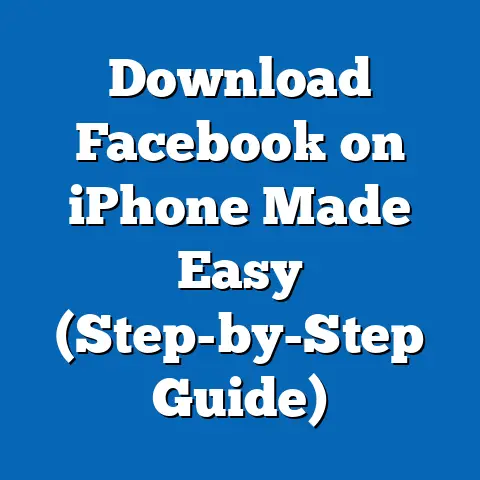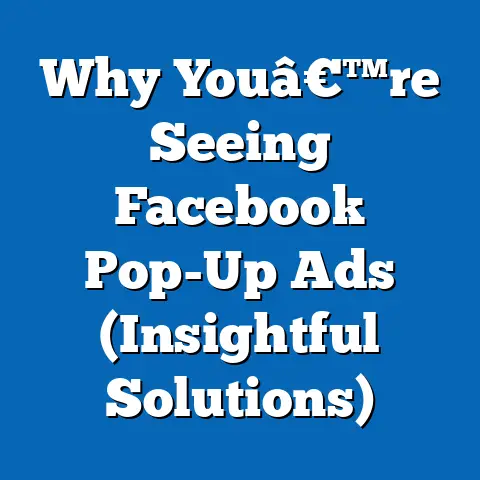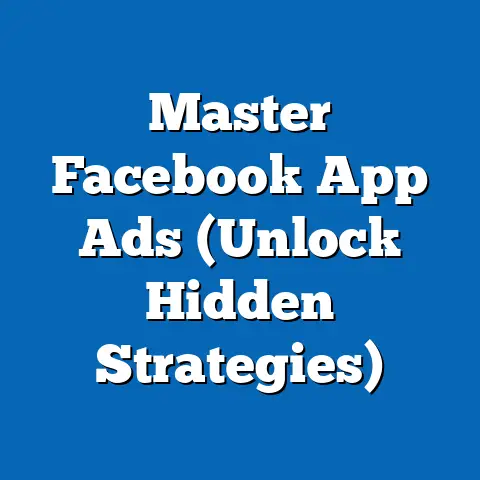Boost Instagram fb ad Strategy (Expert Tips Inside)
In today’s digital age, the advertising landscape is in constant flux. New technologies emerge at breakneck speed, transforming how we connect with audiences. AI-driven analytics, augmented reality ads, and sophisticated targeting algorithms have made it easier than ever for marketers to reach their ideal customer. But, this also means the competition is fiercer. Social media platforms like Instagram and Facebook have become battlegrounds for attention, making a robust and well-executed ad strategy crucial for success.
Section 1: Understanding the Instagram-Facebook Ecosystem
Before you even think about creating an ad, you need to understand the relationship between Instagram and Facebook, and how to leverage that connection to your advantage.
1.1 Overview of the Integration
Did you know that Instagram and Facebook are essentially two sides of the same coin? Since Facebook acquired Instagram in 2012, the two platforms have become deeply integrated, especially when it comes to advertising. What does this mean for you? It means you can manage your Instagram and Facebook ads from a single platform, the Facebook Ads Manager.
This integration offers several key benefits:
- Streamlined Management: Create, manage, and track your ads across both platforms from one central location. This saves time and reduces complexity.
- Cross-Platform Targeting: Leverage Facebook’s powerful targeting capabilities to reach users on both Instagram and Facebook, based on their interests, demographics, behaviors, and more.
- Unified Reporting: Get a holistic view of your ad performance across both platforms, allowing you to make data-driven decisions and optimize your campaigns for maximum impact.
- Consistent Branding: Maintain a consistent brand message and visual identity across both platforms, reinforcing your brand recognition and building trust with your audience.
I remember when this integration first rolled out. It was a game-changer! Suddenly, I could reach a much wider audience with a single campaign, and I could track my results more effectively. It simplified the entire process and allowed me to focus on creating better ads.
1.2 Audience Insights
Understanding your audience is the cornerstone of any successful ad campaign. And when you’re advertising on Instagram and Facebook, you have access to a treasure trove of data about your potential customers.
Here are some key audience insights you should be paying attention to:
- Demographics: Age, gender, location, education level, job title, and relationship status.
- Interests: Hobbies, passions, activities, and topics that your audience is interested in.
- Behaviors: Online activities, purchase history, device usage, and other behaviors that indicate their interests and preferences.
- Connections: Pages they like, groups they belong to, and events they attend.
According to Statista, Facebook boasts nearly 3 billion monthly active users, while Instagram boasts over 2 billion. That’s a massive audience to tap into! But it’s not just about the numbers; it’s about understanding who these users are.
For example, I once worked with a client who was selling eco-friendly baby products. Initially, they were targeting all parents on Facebook and Instagram. But after analyzing their audience insights, we discovered that their ideal customer was a millennial mother who was interested in organic food, sustainable living, and conscious parenting. By narrowing our targeting to this specific segment, we saw a significant increase in our conversion rates and a decrease in our cost per acquisition.
Facebook Audience Insights is a powerful tool that allows you to delve deep into the demographics, interests, and behaviors of your target audience. You can use this tool to:
- Identify your ideal customer: Create a detailed profile of your ideal customer based on their demographics, interests, and behaviors.
- Discover new audiences: Identify potential new audiences that you may not have considered before.
- Refine your targeting: Refine your targeting parameters to reach the most relevant users on Instagram and Facebook.
- Create custom audiences: Create custom audiences based on your existing customer data, website traffic, or app activity.
1.3 The Importance of Visual Content
Instagram is a visual platform, and Facebook is becoming increasingly visual as well. High-quality images and videos are essential for capturing attention and driving engagement.
Here are some tips for creating compelling visual content for your Instagram and Facebook ads:
- Use high-resolution images and videos: Blurry or pixelated visuals will turn users off.
- Choose images and videos that are relevant to your target audience: What are they interested in? What resonates with them?
- Tell a story with your visuals: Don’t just show a product; show how it can improve someone’s life.
- Use bright colors and eye-catching designs: Stand out from the crowd!
- Incorporate your brand identity: Use your brand colors, fonts, and logo to create a consistent brand experience.
I’ve seen countless campaigns succeed or fail based solely on the quality of their visual content. People are bombarded with ads every day, so you need to grab their attention within seconds. A captivating image or video can be the difference between a scroll and a click.
One of my favorite examples of successful visual content is the Airbnb ads. They often feature stunning photos of unique and interesting properties, showcasing the experience of traveling and staying in different places. These visuals are aspirational and engaging, and they perfectly capture the brand’s message.
Takeaway: Understanding the Instagram-Facebook ecosystem, leveraging audience insights, and creating compelling visual content are crucial for success.
Section 2: Setting Up Your Instagram Facebook Ad Strategy
Now that you understand the basics, let’s talk about setting up your ad strategy. This is where you define your goals, identify your target audience, and create a budget.
2.1 Defining Your Goals
What do you want to achieve with your Instagram and Facebook ads? Are you looking to:
- Increase brand awareness?
- Generate leads?
- Drive sales?
- Promote an event?
- Increase website traffic?
Your goals will determine the type of ads you create, the targeting options you use, and the metrics you track.
It’s important to be specific and measurable with your goals. For example, instead of saying “I want to increase brand awareness,” say “I want to increase brand awareness by 20% in the next quarter.” This will give you a clear target to aim for and allow you to track your progress.
I’ve found that many businesses make the mistake of not defining their goals clearly enough. They launch ads without a specific objective in mind, and then they’re disappointed when they don’t see the results they were hoping for. Take the time to define your goals upfront, and you’ll be much more likely to succeed.
2.2 Audience Targeting Techniques
Facebook and Instagram offer a wide range of targeting options to help you reach the right people. Here are some of the most effective techniques:
- Demographic Targeting: Target users based on their age, gender, location, education level, job title, and relationship status.
- Interest Targeting: Target users based on their interests, hobbies, and activities.
- Behavior Targeting: Target users based on their online activities, purchase history, and device usage.
- Custom Audiences: Create custom audiences based on your existing customer data, website traffic, or app activity.
- Lookalike Audiences: Create lookalike audiences based on your custom audiences, targeting users who share similar characteristics and behaviors.
Custom audiences and lookalike audiences are particularly powerful. Custom audiences allow you to target your existing customers, while lookalike audiences allow you to reach new customers who are similar to your best customers.
I once used lookalike audiences to help a client who was selling online courses. We created a custom audience based on their existing students, and then we created a lookalike audience targeting users who shared similar interests and demographics. This resulted in a significant increase in our enrollment rates and a decrease in our cost per acquisition.
2.3 Budgeting and Bidding Strategies
How much should you spend on your Instagram and Facebook ads? This is a common question, and the answer depends on your goals, your target audience, and your budget.
Here are some tips for setting a budget:
- Start small and scale up: Don’t invest all your money at once. Start with a small budget and gradually increase it as you see results.
- Set a daily or lifetime budget: Facebook allows you to set a daily or lifetime budget for your campaigns.
- Track your results and adjust your budget accordingly: If you’re seeing good results, you can increase your budget. If you’re not seeing good results, you can decrease your budget or try a different targeting strategy.
There are also different bidding strategies you can use:
- Cost-Per-Click (CPC): You pay each time someone clicks on your ad.
- Cost-Per-Impression (CPM): You pay for every 1,000 impressions your ad receives.
- Cost-Per-Acquisition (CPA): You pay each time someone takes a specific action, such as making a purchase or signing up for a newsletter.
The best bidding strategy depends on your goals. If you’re looking to drive traffic to your website, CPC might be the best option. If you’re looking to increase brand awareness, CPM might be a better choice. And if you’re looking to generate leads or drive sales, CPA might be the most effective strategy.
Takeaway: Defining your goals, using advanced targeting techniques, and setting a realistic budget are essential for setting up a successful ad strategy.
Section 3: Crafting Compelling Ad Content
Now that you have your strategy in place, it’s time to create some compelling ad content. This is where you tell your story, showcase your products or services, and encourage users to take action.
3.1 Importance of Storytelling
People are more likely to remember and engage with stories than with facts or figures. That’s why storytelling is such a powerful tool for advertising.
Here are some tips for telling a compelling story in your ads:
- Focus on the benefits, not the features: Tell users how your product or service can improve their lives.
- Use emotional language: Connect with users on an emotional level.
- Create a sense of urgency: Encourage users to take action now.
- Use testimonials and social proof: Show users that other people have had positive experiences with your product or service.
I’ve seen countless ads that simply list the features of a product without telling a story. These ads rarely get any engagement. But when you tell a story that resonates with your audience, you’ll see a significant increase in your click-through rates and conversion rates.
One of my favorite examples of storytelling in advertising is the Dove Real Beauty campaign. This campaign features real women of all shapes and sizes, challenging traditional beauty standards and promoting self-acceptance. This campaign resonated with millions of women around the world and helped to build a strong brand identity for Dove.
3.2 Designing Eye-Catching Visuals
As I mentioned earlier, visual content is crucial for capturing attention on Instagram and Facebook. Here are some tips for designing eye-catching visuals:
- Use high-quality images and videos: Blurry or pixelated visuals will turn users off.
- Choose images and videos that are relevant to your target audience: What are they interested in? What resonates with them?
- Tell a story with your visuals: Don’t just show a product; show how it can improve someone’s life.
- Use bright colors and eye-catching designs: Stand out from the crowd!
- Incorporate your brand identity: Use your brand colors, fonts, and logo to create a consistent brand experience.
There are also many tools and resources you can use to create stunning visuals, even if you don’t have a design background. Canva is a popular online design tool that offers a wide range of templates, graphics, and fonts. Adobe Creative Cloud is another powerful suite of design tools that includes Photoshop, Illustrator, and Premiere Pro.
3.3 Effective Call-to-Actions
A call-to-action (CTA) is a phrase that encourages users to take a specific action, such as clicking on your ad, visiting your website, or making a purchase. A strong CTA is essential for driving results from your ads.
Here are some tips for creating effective CTAs:
- Use action verbs: Use verbs that encourage action, such as “Shop Now,” “Learn More,” “Sign Up,” or “Get Started.”
- Create a sense of urgency: Use phrases that create a sense of urgency, such as “Limited Time Offer” or “Don’t Miss Out.”
- Make it clear what you want users to do: Be specific about what you want users to do, such as “Shop Now and Save 20%” or “Sign Up for Our Free Newsletter.”
- Make your CTA visually prominent: Use a button or a different color to make your CTA stand out.
I’ve seen countless ads with weak or nonexistent CTAs. These ads rarely get any clicks or conversions. But when you use a strong and clear CTA, you’ll see a significant increase in your results.
Takeaway: Storytelling, eye-catching visuals, and effective CTAs are essential for crafting compelling ad content that drives results.
Section 4: Analyzing and Optimizing Your Ad Performance
Creating great ads is only half the battle. You also need to analyze your ad performance and optimize your campaigns for maximum impact.
4.1 Using Facebook Ads Manager
Facebook Ads Manager is your command center for managing your Instagram and Facebook ads. It provides a wealth of data and insights that you can use to track your performance and make informed decisions.
Here are some key metrics you should be monitoring:
- Impressions: The number of times your ad was shown.
- Reach: The number of unique people who saw your ad.
- Clicks: The number of times people clicked on your ad.
- Click-Through Rate (CTR): The percentage of people who saw your ad and clicked on it.
- Cost-Per-Click (CPC): The average cost you paid for each click on your ad.
- Conversions: The number of people who took a specific action after clicking on your ad, such as making a purchase or signing up for a newsletter.
- Conversion Rate: The percentage of people who clicked on your ad and took a specific action.
- Cost-Per-Acquisition (CPA): The average cost you paid for each conversion.
By monitoring these metrics, you can identify which ads are performing well and which ads are not. You can then use this information to optimize your campaigns and improve your results.
4.2 A/B Testing for Better Results
A/B testing is a powerful technique for optimizing your ads. It involves creating two versions of an ad and testing them against each other to see which one performs better.
You can A/B test different elements of your ads, such as:
- Images: Test different images to see which one captures the most attention.
- Headlines: Test different headlines to see which one generates the most clicks.
- Body copy: Test different body copy to see which one drives the most conversions.
- CTAs: Test different CTAs to see which one encourages the most action.
- Targeting: Test different targeting options to see which one reaches the most relevant audience.
To conduct an A/B test, you need to create two versions of your ad that are identical except for the element you’re testing. Then, you run both ads simultaneously and track their performance. The ad that performs better is the winner.
I’ve used A/B testing to significantly improve the performance of my ads. For example, I once tested two different headlines for an ad promoting a new product. The first headline was “Introducing the New [Product Name].” The second headline was “Solve Your [Problem] with the New [Product Name].” The second headline performed much better, generating a 50% higher click-through rate.
4.3 Adjusting Strategies Based on Data
The data you collect from Facebook Ads Manager and A/B testing can be used to inform your strategy adjustments. If you’re seeing good results, you can scale up your successful ads. If you’re not seeing good results, you can pivot and try a different approach.
Here are some common strategy adjustments you can make:
- Adjust your targeting: If you’re not reaching the right people, you can adjust your targeting options to reach a more relevant audience.
- Change your ad creative: If your ads aren’t capturing attention, you can change your images, headlines, or body copy.
- Adjust your bidding strategy: If you’re paying too much for clicks or conversions, you can adjust your bidding strategy.
- Pause or delete underperforming ads: If an ad is not performing well, you can pause or delete it to avoid wasting money.
It’s important to be flexible and willing to experiment with different strategies. The advertising landscape is constantly evolving, so you need to be able to adapt to change.
Takeaway: Analyzing your ad performance, conducting A/B tests, and adjusting your strategies based on data are essential for optimizing your campaigns and maximizing your ROI.
Section 5: Staying Ahead of Trends and Innovations
The world of social media advertising is constantly changing. New trends emerge, new technologies are developed, and new algorithms are implemented. To stay ahead of the curve, you need to be aware of these changes and adapt your strategies accordingly.
5.1 Emerging Trends in Social Media Advertising
Here are some of the emerging trends in social media advertising:
- Influencer Marketing: Partnering with influencers to promote your products or services.
- User-Generated Content (UGC): Using content created by your customers in your ads.
- Shoppable Posts: Allowing users to purchase products directly from your Instagram or Facebook posts.
- Augmented Reality (AR) Ads: Using AR technology to create interactive and engaging ad experiences.
- Personalized Advertising: Using data to personalize ads based on individual user preferences.
I’ve seen many businesses successfully integrate these trends into their ad strategies. For example, I worked with a clothing brand that partnered with several fashion influencers to promote their new line of clothing. The influencers created posts and videos showcasing the clothing, and they shared them with their followers. This resulted in a significant increase in brand awareness and sales.
5.2 The Role of AI and Automation
AI and automation are playing an increasingly important role in social media advertising. AI-powered tools can help you:
- Automate ad creation: Generate ad copy and visuals automatically.
- Optimize targeting: Identify the most relevant audience for your ads.
- Manage bidding: Automate your bidding strategy to maximize your ROI.
- Analyze performance: Track your ad performance and identify areas for improvement.
There are many AI-powered tools available, such as Phrasee, Persado, and Albert. These tools can help you streamline your ad processes and improve your results.
5.3 Future-Proofing Your Ad Strategy
To future-proof your ad strategy, you need to:
- Stay informed: Keep up-to-date with the latest trends and innovations in social media advertising.
- Be adaptable: Be willing to experiment with new strategies and technologies.
- Focus on the user experience: Create ads that are relevant, engaging, and valuable to your target audience.
- Embrace data: Use data to inform your decisions and optimize your campaigns.
The advertising landscape is constantly evolving, so you need to be prepared to adapt to change. By staying informed, being adaptable, focusing on the user experience, and embracing data, you can future-proof your ad strategy and stay ahead of the competition.
Takeaway: Staying ahead of trends, embracing AI and automation, and future-proofing your ad strategy are essential for long-term success.
Conclusion
Boosting your Instagram and Facebook ad strategy requires a multifaceted approach. It’s not just about creating pretty ads; it’s about understanding the platform, knowing your audience, crafting compelling content, analyzing your performance, and staying ahead of the curve.
By following the expert tips I’ve shared in this guide, you can take your Instagram and Facebook ads to the next level. Remember to:
- Understand the Instagram-Facebook ecosystem: Leverage the integration between the two platforms to streamline your management and reach a wider audience.
- Define your goals: Set specific and measurable goals for your ad campaigns.
- Use advanced targeting techniques: Reach the right people with your ads.
- Craft compelling ad content: Tell a story, use eye-catching visuals, and include a strong CTA.
- Analyze your ad performance: Track your metrics and identify areas for improvement.
- A/B test your ads: Experiment with different elements to see what works best.
- Adjust your strategies based on data: Be flexible and willing to adapt to change.
- Stay ahead of trends: Keep up-to-date with the latest innovations in social media advertising.
- Embrace AI and automation: Use AI-powered tools to streamline your processes and improve your results.
- Future-proof your ad strategy: Be prepared to adapt to the ever-changing advertising landscape.
The world of social media advertising is competitive, but with the right strategy and execution, you can achieve your business goals and stay ahead of the competition. So, go out there, implement these strategies, and watch your Instagram and Facebook ads soar!

